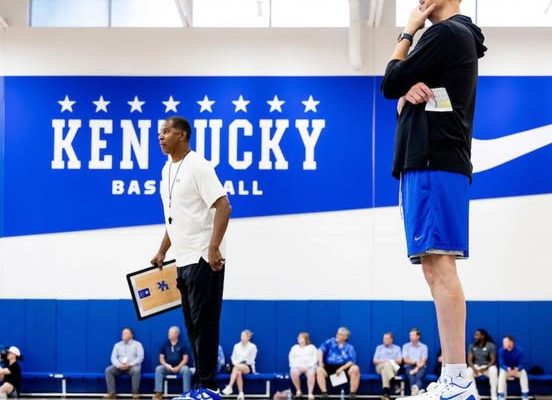**Pope Is Cooking Something CRAZY in Practice… Kentucky’s Summer Workouts Look NOTHING Like What We’ve Seen Before.**
The whispers coming out of Lexington this summer aren’t just intriguing—they’re borderline unbelievable. Kentucky basketball, under new head coach Mark Pope, is undergoing a radical transformation in practice, and if early reports hold true, the Wildcats might be unleashing a brand of basketball we’ve never seen before in college hoops. Forget traditional positions. Forget predictable sets. Pope is experimenting with lineups so wild, so unorthodox, that they could either revolutionize the game or crash spectacularly. And yet… it might just be genius.
One of the most jarring sights in Kentucky’s summer workouts? Big men running point. Not just bringing the ball up in transition—actually initiating offense, making reads, and even pulling up from deep. Pope, a former BYU coach known for his offensive creativity, is pushing the boundaries of conventional basketball wisdom. Imagine 6’10” forwards handling like guards, wings posting up like centers, and guards crashing the glass like power forwards. This isn’t just small-ball—it’s *no*-ball, at least in the traditional sense.
Sources close to the program describe scrimmages where lineups shift every few possessions, with players cycling through roles they’ve never played before. A traditional center might suddenly find himself sprinting to the corner for a three, while a point guard sets a down screen in the post. The constant movement and unpredictability are designed to keep defenses guessing—and, more importantly, to maximize versatility.
At first glance, this sounds like madness. College basketball thrives on structure, and Kentucky has long been a program built on elite talent executing disciplined systems. But Pope’s approach isn’t just random experimentation—it’s a calculated gamble based on two key principles:
1. **The Modern Game Rewards Versatility** – The NBA has shifted toward positionless basketball, where switchability and skill trump traditional size-based roles. Pope, who played under Rick Pitino and has coached at a high level, understands that the best way to exploit mismatches is by having five players who can all shoot, pass, and dribble. If Kentucky’s bigs can stretch the floor and their guards can post up, they become nearly impossible to defend in conventional ways.
2. **Depth Through Flexibility** – Kentucky’s roster this season isn’t stacked with five-star one-and-dones like in years past. Instead, Pope has assembled a mix of transfers and developmental players who might not be elite in one area but are capable in multiple. By blurring positional lines, he can create matchup nightmares without relying on a singular superstar.
According to insiders, Kentucky’s intrasquad scrimmages have been… chaotic. Not in a bad way, but in a way that suggests Pope is actively encouraging controlled madness. There are possessions where a 7-footer will grab a rebound, push the break himself, and hit a trailing guard for a three. Other times, a guard will post up while a forward sets a flare screen for a three-point shooter.
The goal? To make every player comfortable in every situation. If a team presses, any Wildcat can bring the ball up. If a defense switches, any player can exploit a mismatch. It’s basketball without constraints—a system where players are encouraged to read and react rather than follow rigid play calls.
Of course, this strategy isn’t without risk. Positionless basketball only works if players are smart enough to make the right reads and skilled enough to execute in unfamiliar roles. If Kentucky’s big men can’t actually handle the ball under pressure, or if their guards get bullied in the post, the experiment could backfire spectacularly.
There’s also the question of chemistry. Unstructured systems require high-level communication and trust. If players aren’t fully bought in—or if they revert to old habits in crunch time—the whole thing could collapse when it matters most.
But if it *does* work? Kentucky could be the most unpredictable team in the country by March. Imagine preparing for the Wildcats in the NCAA Tournament and not knowing who will initiate the offense, which big might step out and hit threes, or which guard might suddenly post up. Scouting reports become nearly useless because there *is* no set pattern.
And that’s where Pope’s gamble could pay off in a major way. In a single-elimination tournament, confusion is a weapon. If Kentucky can force opponents into defensive breakdowns simply by being unorthodox, they could catch more talented teams off guard (pun intended).
Right now, it’s too early to tell whether Mark Pope’s experiment will make Kentucky a contender or a cautionary tale. But one thing is certain: the Wildcats are doing things differently. In a sport that often resists change, Pope is pushing the limits of what’s possible.
If this works, we might look back at the 2024-25 season as the year Kentucky redefined college basketball. If it fails? Well, at least it’ll be fun to watch. Either way, Pope is cooking something crazy—and the entire sport is about to find out if it’s a masterpiece or a disaster.
One thing’s for sure: March just got a whole lot more interesting.



